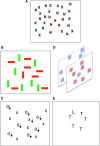Parallel distractor rejection as a binding mechanism in search
- PMID: 22908002
- PMCID: PMC3414861
- DOI: 10.3389/fpsyg.2012.00278
Parallel distractor rejection as a binding mechanism in search
Abstract
The relatively common experimental visual search task of finding a red X amongst red O's and green X's (conjunction search) presents the visual system with a binding problem. Illusory conjunctions (ICs) of features across objects must be avoided and only features present in the same object bound together. Correct binding into unique objects by the visual system may be promoted, and ICs minimized, by inhibiting the locations of distractors possessing non-target features (e.g., Treisman and Sato, 1990). Such parallel rejection of interfering distractors leaves the target as the only item competing for selection; thus solving the binding problem. In the present article we explore the theoretical and empirical basis of this process of active distractor inhibition in search. Specific experiments that provide strong evidence for a process of active distractor inhibition in search are highlighted. In the final part of the article we consider how distractor inhibition, as defined here, may be realized at a neurophysiological level (Treisman and Sato, 1990).
Keywords: attention; conjunction search; feature binding; inhibition; visual search.
Figures




Similar articles
-
A feature and conjunction visual search immersive virtual reality serious game for measuring spatial and distractor inhibition attention using response time and action kinematics.J Clin Exp Neuropsychol. 2023 May;45(3):292-303. doi: 10.1080/13803395.2023.2218571. Epub 2023 Jun 1. J Clin Exp Neuropsychol. 2023. PMID: 37260369
-
Neural responses to target features outside a search array are enhanced during conjunction but not unique-feature search.J Neurosci. 2014 Feb 26;34(9):3390-401. doi: 10.1523/JNEUROSCI.3630-13.2014. J Neurosci. 2014. PMID: 24573295 Free PMC article.
-
The Interaction of Spatial and Object Pathways: Evidence from Balint's Syndrome.J Cogn Neurosci. 1997 May;9(3):295-317. doi: 10.1162/jocn.1997.9.3.295. J Cogn Neurosci. 1997. PMID: 23965009
-
Learned distractor rejection persists across target search in a different dimension.Atten Percept Psychophys. 2023 Apr;85(3):785-795. doi: 10.3758/s13414-022-02559-3. Epub 2022 Aug 31. Atten Percept Psychophys. 2023. PMID: 36045310
-
Identifying visual targets amongst interfering distractors: Sorting out the roles of perceptual load, dilution, and attentional zoom.Atten Percept Psychophys. 2016 Oct;78(7):1822-38. doi: 10.3758/s13414-016-1149-9. Atten Percept Psychophys. 2016. PMID: 27250363 Review.
Cited by
-
Effects of spatial location on distractor interference.J Vis. 2024 Sep 3;24(9):4. doi: 10.1167/jov.24.9.4. J Vis. 2024. PMID: 39240585 Free PMC article.
-
Does attentional suppression occur at the level of perception or decision-making? Evidence from Gaspelin et al.'s (2015) probe letter task.Psychol Res. 2023 Jun;87(4):1243-1255. doi: 10.1007/s00426-022-01734-3. Epub 2022 Sep 12. Psychol Res. 2023. PMID: 36094666 Free PMC article.
-
Extrafoveal preview benefit during free-viewing visual search in the monkey.J Vis. 2014 Jan 8;14(1):6. doi: 10.1167/14.1.6. J Vis. 2014. PMID: 24403392 Free PMC article.
-
Entrainment of Human Alpha Oscillations Selectively Enhances Visual Conjunction Search.PLoS One. 2015 Nov 25;10(11):e0143533. doi: 10.1371/journal.pone.0143533. eCollection 2015. PLoS One. 2015. PMID: 26606255 Free PMC article.
-
The process of feature binding.Front Psychol. 2013 Apr 18;4:207. doi: 10.3389/fpsyg.2013.00207. eCollection 2013. Front Psychol. 2013. PMID: 23616781 Free PMC article. No abstract available.
References
-
- Bernstein L. J., Robertson L. C. (1998). Independence between illusory conjunctions of color and motion with shape following bilateral parietal lesions. Psychol. Sci. 9, 167–17510.1111/1467-9280.00033 - DOI
Grants and funding
LinkOut - more resources
Full Text Sources

